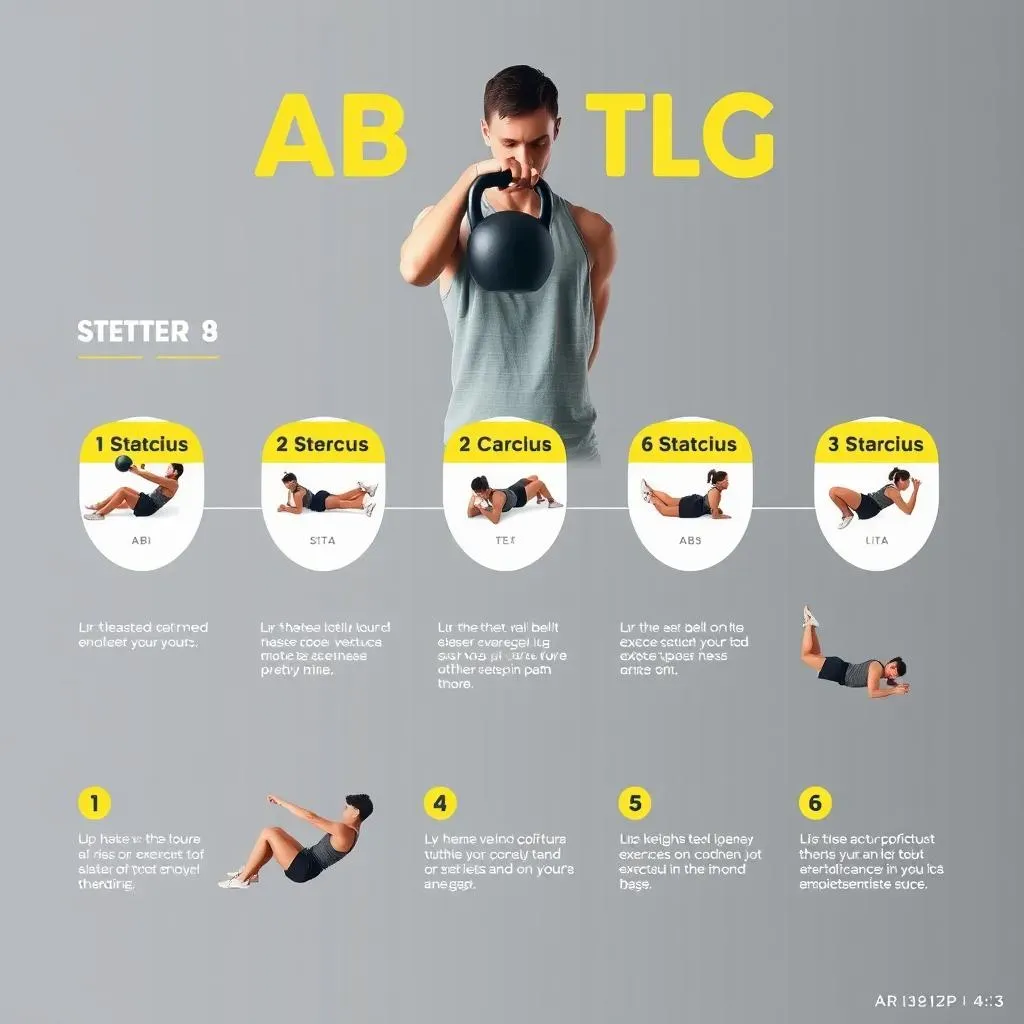Table of Contents
Ready to sculpt your dream abs? Forget boring crunches! This article is your guide to the ultimate kettlebell ab circuit, a dynamic and effective workout that will challenge your core like never before. We'll explore a range of exercises perfect for all fitness levels, from beginner-friendly moves to advanced techniques that will push your limits. You'll learn the proper form for each exercise to maximize results and prevent injuries. This isn't just about aesthetics; a strong core is crucial for overall fitness, stability, and injury prevention. We'll show you how to build your own personalized kettlebell ab circuit workout, step-by-step, so you can tailor it to your goals and time constraints. Whether you're a seasoned athlete or just starting your fitness journey, this kettlebell ab circuit will help you achieve a stronger, more defined core. Get ready to unleash your inner strength and discover the power of this transformative workout. Let's dive into the world of kettlebell ab circuits and unlock your core potential!
Kettlebell Ab Circuit: Exercises for a Stronger Core

Kettlebell Ab Circuit: Exercises for a Stronger Core
Fundamental Kettlebell Ab Exercises
Let's kick things off with some foundational kettlebell exercises that directly target your abs. Think of these as the building blocks of your core strength. We're not talking about fancy, complicated moves; these are simple, effective exercises that deliver results. The key is mastering the correct form to avoid injury and maximize the benefits. Imagine your core as a powerful engine – these exercises are the fuel that keeps it running smoothly and efficiently.
One excellent example is the Kettlebell Russian Twist. Start by sitting on the floor with your knees bent, feet flat on the ground, and holding a kettlebell close to your chest. Lean back slightly, engaging your core, and twist your torso from side to side, tapping the kettlebell on the floor beside you with each twist. This exercise is fantastic for working your obliques – those muscles on the sides of your waist – that are crucial for a strong and stable core. Remember, controlled movements are key here. Don't rush it; feel the burn in your obliques with each rep.
Exercise | Target Muscles | Tips |
|---|---|---|
Kettlebell Russian Twist | Obliques, Rectus Abdominis | Maintain a straight back, controlled movements. |
Kettlebell Sit-Ups | Rectus Abdominis | Engage your core throughout the movement. |
Kettlebell Windmills | Obliques, Core Stabilizers | Maintain a straight arm and leg. |
Intermediate and Advanced Kettlebell Ab Exercises
Once you've mastered the basics, it's time to level up your kettlebell ab circuit. We'll introduce some more challenging exercises that require more coordination, strength, and balance. These exercises not only target your abs but also engage other muscle groups, providing a more holistic core workout. Think of this as building the next level of your core engine – adding turbochargers to enhance its power and efficiency.
The Kettlebell Turkish Get-Up is a prime example of a challenging yet rewarding exercise. This dynamic movement involves a series of controlled steps that work your entire body, with a strong emphasis on core stability. It's a full-body exercise disguised as an ab workout! It requires practice to master the correct form, but the benefits are immense. You'll build incredible core strength, improve balance, and enhance your overall body coordination. Don't be discouraged if you struggle at first – persistence is key. Start slowly, focus on proper form, and gradually increase the weight as you improve.
- Kettlebell Turkish Get-Up
- Kettlebell Plank
- Kettlebell Wood Chops
"A strong core is the foundation of all athletic movements." - Unknown
Mastering Kettlebell Ab Circuit Form: Tips and Tricks

Mastering Kettlebell Ab Circuit Form: Tips and Tricks
Maintaining Proper Posture
So, you're ready to tackle a kettlebell ab circuit? Awesome! But before you start swinging those weights like a pro, let's talk about posture. Think of your spine as a precious, delicate thing – you wouldn't want to hurt it, right? Maintaining a neutral spine throughout each exercise is crucial. This means keeping your back straight, but not overly arched or rounded. Imagine a string pulling you up from the crown of your head. This helps engage your core muscles effectively and prevents injuries. A slight natural curve in your lower back is fine, but avoid excessive arching or slouching.
Many people make the mistake of rounding their back during exercises like kettlebell Russian twists or sit-ups. This puts unnecessary stress on your spine and can lead to pain. Focus on engaging your core muscles to support your back and maintain that neutral spine. If you find yourself struggling to maintain good posture, start with lighter weights and focus on perfecting your form before increasing the intensity. Remember, quality over quantity!
Exercise | Posture Tip |
|---|---|
Kettlebell Russian Twist | Keep your back straight, avoid rounding. |
Kettlebell Sit-ups | Engage your core to support your back. |
Kettlebell Windmills | Maintain a long spine, avoid collapsing. |
Breathing and Core Engagement
Breathing might seem obvious, but it's a game-changer in kettlebell training. Proper breathing helps stabilize your core and improves the effectiveness of your movements. As you begin each rep, inhale deeply, filling your lungs with air. Then, as you perform the exercise, exhale forcefully, squeezing your core muscles. This creates intra-abdominal pressure, which acts like a natural weight belt, supporting your spine and enhancing core stability. Think of it as giving your core muscles an extra boost of power!
Many beginners hold their breath during strenuous exercises, which isn't ideal. Holding your breath can restrict blood flow and make it harder to maintain proper form. Consistent, controlled breathing is key to preventing injuries and maximizing the benefits of your kettlebell ab circuit. Try to synchronize your breathing with your movements – inhale during the less strenuous part of the movement and exhale during the more challenging phase. This will help you maintain a steady rhythm and prevent fatigue.
- Inhale deeply at the start of each rep.
- Exhale forcefully as you engage your core muscles.
- Maintain a steady breathing rhythm throughout the circuit.
"The breath is the bridge between the mind and the body." - Unknown
Building Your Kettlebell Ab Circuit Workout: A StepbyStep Guide

Building Your Kettlebell Ab Circuit Workout: A StepbyStep Guide
Building Your First Kettlebell Ab Circuit
So, you've learned the exercises, mastered the form – now it's time to build your very own killer kettlebell ab circuit! Don't feel pressured to create a super intense workout right away. Start with a manageable routine and gradually increase the intensity as you get stronger. Think of it like building a house – you wouldn't try to build the roof before laying the foundation, right? This is about building a strong core, not breaking yourself. We'll guide you through a simple process to create a workout that suits your fitness level and goals. Remember, consistency is key, so choose a routine you can realistically stick to.
First, select 3-4 exercises from the ones we've covered. For a beginner circuit, you might choose Kettlebell Russian Twists, Kettlebell Sit-Ups, and Kettlebell Windmills. For each exercise, decide on a set number of repetitions (reps) and sets. Start with 2-3 sets of 10-15 reps for each exercise. Once you've chosen your exercises and reps, you need to determine the rest time between sets. A good starting point is 60 seconds of rest. As you progress, you can reduce the rest time to increase the intensity of your workout. Remember, listen to your body – if you're feeling overly fatigued, take a longer break.
Step | Action |
|---|---|
1 | Choose 3-4 exercises. |
2 | Set reps and sets (beginner: 2-3 sets of 10-15 reps). |
3 | Determine rest time (beginner: 60 seconds). |
Progressing Your Kettlebell Ab Circuit
Congratulations, you've built your first kettlebell ab circuit! Now, the key is consistency. Aim to perform your circuit 2-3 times per week, allowing for rest days in between. As you get stronger, you can gradually increase the intensity of your workout. This could involve increasing the number of sets, reps, or the weight of your kettlebell. You could also introduce more challenging exercises as you progress. Remember, it's a journey, not a race. Don't get discouraged if you don't see results immediately. Consistency and proper form are key to achieving your fitness goals. Celebrate your progress along the way – each workout is a step closer to your stronger core!
Consider incorporating variations into your exercises to keep things interesting and challenge your muscles in new ways. For example, you could try performing Russian twists with a slower, more controlled movement, or add a pulse at the end of each rep. You could also experiment with different kettlebell weights to find the right challenge for your fitness level. Remember, it’s all about finding a balance between pushing yourself and avoiding injury. Listen to your body, and don't hesitate to adjust your routine as needed.
- Increase sets or reps.
- Increase kettlebell weight.
- Introduce new exercises.
- Vary exercise tempos (speed).
"The body achieves what the mind believes." - Napoleon Hill
Advanced Kettlebell Ab Circuits for Experienced Athletes

Advanced Kettlebell Ab Circuits for Experienced Athletes
Advanced Kettlebell Ab Exercises and Circuit Design
Alright, seasoned athlete, let's talk advanced kettlebell ab circuits. We're moving beyond the basics now, into territory that demands strength, coordination, and a serious dose of grit. Think of this as the Formula 1 of core workouts – high-octane, demanding, and incredibly rewarding. We're not just building a strong core here; we're sculpting a powerhouse of stability and strength. This isn't about simple reps; it's about controlled, powerful movements that will leave you feeling both challenged and exhilarated. We'll explore exercises that push your limits, forcing your core to adapt and grow stronger than ever before.
Consider incorporating dynamic movements like the Kettlebell Turkish Get-Up with added weight, or variations of the Windmill that challenge your balance and stability. Think about adding plyometrics – explosive movements that combine strength and speed – to your circuit, such as explosive Russian twists or jump squats with a kettlebell overhead. The key here is to challenge your body in new and innovative ways, pushing your limits and forcing your muscles to adapt. Remember to prioritize proper form to avoid injury and maximize results. This isn't about brute force; it's about controlled power and precision.
Exercise | Progression Tip |
|---|---|
Kettlebell Turkish Get-Up | Increase weight, decrease rest time. |
Kettlebell Windmill | Add a pause at the bottom, increase reps. |
Kettlebell Swings | Increase weight, try one-arm variations. |
Programming Advanced Kettlebell Ab Circuits
Designing an advanced kettlebell ab circuit requires a strategic approach. You're no longer just working on basic strength; you're aiming for explosive power, enhanced stability, and improved coordination. This is about pushing the boundaries of what your body is capable of. Remember, recovery is just as important as the workout itself. Adequate rest allows your muscles to repair and rebuild, leading to greater strength and endurance. Without proper recovery, you risk injury and plateauing in your progress. Don't neglect your rest days; they are just as crucial to your success as the training days.
Think about incorporating circuit training principles: high intensity, short rest periods, and a variety of exercises that work different muscle groups. You might include a series of explosive movements followed by isometric holds or slow, controlled repetitions. This creates a powerful stimulus for muscle growth and strength development. Consider adding elements of metabolic conditioning, like high-intensity interval training (HIIT), to further challenge your cardiovascular system and burn more calories. Remember to listen to your body; adjust the intensity and duration of your workouts based on your individual needs and recovery capabilities. Progress gradually, avoid burnout, and celebrate your achievements along the way.
- Incorporate HIIT principles.
- Use a variety of exercises and rep schemes.
- Prioritize proper form and recovery.
- Listen to your body and adjust as needed.
"The difference between ordinary and extraordinary is that little extra." - Jimmy Johnson